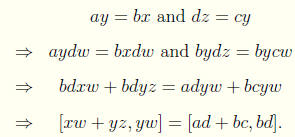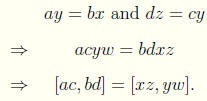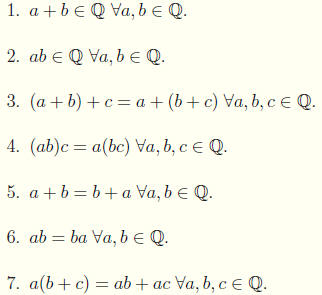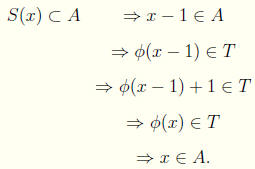INTEGER AND RATIONAL NUMBERS
Theorem 7.7 The ordering of rational numbers is
well defined.
Proof Let [x, y] = [a, b], [z,w] = [c, d], and [x, y] < [z,w] with b, d,
y, w >
0. We thus have

Hence the ordering is well defined.
We define addition and multiplication as follows,

Theorem 7.8 Addition and multiplication of rational
numbers are well
defined.
Proof Let [x, y] = [a, b] and [z,w] = [c, d].
For addition we have

Hence addition is well defined.
For multiplication we have

Hence multiplication is well defined.
Just as there is a natural embedding of the natural numbers into the
integers , there is the natural embedding of the integers into the rational
numbers given by the injection,

It is easy to verify that this injection is an embedding.
A Field
We leave it the reader to verify the following properties of Q .

8.  such that a + e = e
+ a =
such that a + e = e
+ a = ![]()
9.  such that au = ua =
such that au = ua =

10.  such that a + (-a) = (-a) + a = 0
such that a + (-a) = (-a) + a = 0
11.  such that aa-1 = a-1a = 1
such that aa-1 = a-1a = 1
The first 10 properties are identical to the properties of
an Integral Domain.
Property 11* is replaced by property 11 where a-1 is called the multiplicative
inverse, or reciprocal .
Any set with two binary operations satisfying these 11 properties is called
a Field.
Exercise Show that every field is an integral domain. That is to say, every
field has no zero divisors .
Differences and Quotients
Definition The difference between integers or rational numbers a and b
is a + (-b), which is written a - b.
Definition The quotient of two rational numbers a and b is a · b-1, which
is written  .
.
We can see that difference and quotient can be regarded as a binary oper-
ations, we also notice that neither operation is commutative nor associative.
Exercise For any two rational numbers p < q, show that
 .
.
Exercise Show that
1. If p, q, r are rational numbers where p ≤ q and r > 0, then pr ≤ qr.
2. If p, q, r are rational numbers where p ≤ q and r < 0, then pr ≥ qr.
3. If p and q are positive rational numbers, then
 :
:
Mathematical Induction
The next theorem is a special case of transfinite induction, that is widely
used in many situations. Before we state and prove the theorem we need two
small lemmas that we present as exercises .
Exercise 1. Define the map Ø : N →
 by Ø(a) = [a + 1, 0]. Show that
by Ø(a) = [a + 1, 0]. Show that
Ø(a) + 1 = Ø(a + 1).
Exercise 2. Show that  is order isomorphic to ω.
is order isomorphic to ω.
Theorem 7.9 The Principle of Mathematical Induction If
 such
such
that the following conditions are true:
i. 1 ∈ T
ii. if k ∈ T, then k + 1 ∈ T,
then T =  .
.
Proof Consider the order preserving bijection Ø : ω →
 defined by
defined by
Ø(a) = [a + 1, 0]. Let A = Ø-1(T). Let x ∈ ω such that S(x)
 A.
A.
If x = 0, then Ø(x) = 1 ∈ T => x ∈ A. If x ≠ 0, then

Thus by Transfinite Induction
 .
.
The Cardinality of Integers and Rational Numbers
| Prev | Next |